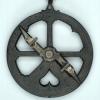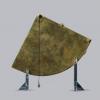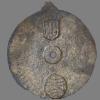Model of the ‘Santa María’, wood and cloth
Commentary
The Santa María was the flagship of Christopher Columbus' first voyage to the New World in 1492. The ship was a medium-sized carrack with three masts and is estimated to be 70 feet in length. Carracks were developed in the fourteenth and fifteenth centuries and were a key advancement in marine technology. Due to their size and sets of both square and lateen (triangular) sails, they were able to sail faster and for longer periods of time.
Having previously been owned by Juan de la Cosa (c. 1450-1510), a Castilian cartographer and navigator, the Santa María was claimed by Queen Isabella I. The Spanish Crown then granted the ship to Columbus for his journey towards India. Although Columbus had set out to find an alternative route to Asia, he instead landed in the Bahamas, becoming the first European to discover South America.
On Christmas of 1492, having visited both Cuba and Hispaniola, the Santa María hit the ground on the shores of Haiti. The ship was beyond repair, and Columbus and his men dismantled it and used the timber to construct the settlement 'Fort Navidad' (Christmas fort) in a local indigenous village.



